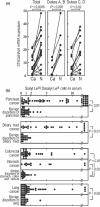Altered expression of glycan genes in cancers induced by epigenetic silencing and tumor hypoxia: clues in the ongoing search for new tumor markers
- PMID: 20085584
- PMCID: PMC11158919
- DOI: 10.1111/j.1349-7006.2009.01455.x
Altered expression of glycan genes in cancers induced by epigenetic silencing and tumor hypoxia: clues in the ongoing search for new tumor markers
Abstract
The glycan molecules that preferentially appear in cancers are clinically utilized as serum tumor markers. The exact reason, however, why glycans are useful as tumor markers remain elusive. Here, we will summarize lessons learned from well-established cancer-associated glycans, and propose strategies to develop new cancer markers. Our recent results on cancer-associated glycans, sialyl Lewis A and sialyl Lewis X, indicated that the repressed transcription of some glycan genes by epigenetic silencing during early carcinogenesis, and the transcriptional induction of some other glycan genes by tumor hypoxia accompanying cancer progression at locally advanced stages, are two major factors determining cancer-associated glycan expression. Multiple genes are involved in glycan synthesis, and epigenetic silencing of a part of such genes leads to accumulation of glycans having truncated incomplete structures, which are readily detected by specific antibodies. Glycans are very unique and advantageous as marker molecules because they are capable of reflecting epigenetic silencing in their structures. Transcriptional induction of some glycan genes by tumor hypoxia at the later stages produces further glycan modifications, such as an unusual increase of the N-glycolyl sialic acid residues in the glycan molecules. The entire process of malignant transformation thus creates abnormal glycans, whose structures reveal the effects of both epigenetic silencing and tumor hypoxia. The second advantage of a glycan marker over a proteinous marker is that they can reflect the plurality of genetic anomalies in a singular molecule, as it is synthesized by the cooperative action of multiple genes. Glycans are sometimes covalently bound to well-known cancer-associated proteins, such as CD44v, and this eventually contributes to a high cancer specificity and functional relevancy in cancer progression.
Figures






Similar articles
-
Carbohydrate antigen sialyl Lewis a--its pathophysiological significance and induction mechanism in cancer progression.Chang Gung Med J. 2007 May-Jun;30(3):189-209. Chang Gung Med J. 2007. PMID: 17760270 Review.
-
Altered sphingolipid metabolism induced by tumor hypoxia - new vistas in glycolipid tumor markers.FEBS Lett. 2010 May 3;584(9):1872-8. doi: 10.1016/j.febslet.2009.11.019. Epub 2009 Nov 11. FEBS Lett. 2010. PMID: 19913543 Free PMC article. Review.
-
Altered glycosylation in cancer: A promising target for biomarkers and therapeutics.Biochim Biophys Acta Rev Cancer. 2021 Jan;1875(1):188464. doi: 10.1016/j.bbcan.2020.188464. Epub 2020 Nov 4. Biochim Biophys Acta Rev Cancer. 2021. PMID: 33157161 Free PMC article. Review.
-
Epigenetic silencing of the synthesis of immunosuppressive Siglec ligand glycans by NF-κB/EZH2/YY1 axis in early-stage colon cancers.Biochim Biophys Acta Gene Regul Mech. 2019 Feb;1862(2):173-183. doi: 10.1016/j.bbagrm.2019.01.002. Epub 2019 Feb 1. Biochim Biophys Acta Gene Regul Mech. 2019. PMID: 30716533
-
Current relevance of incomplete synthesis and neo-synthesis for cancer-associated alteration of carbohydrate determinants--Hakomori's concepts revisited.Biochim Biophys Acta. 2008 Mar;1780(3):525-31. doi: 10.1016/j.bbagen.2007.10.007. Epub 2007 Oct 22. Biochim Biophys Acta. 2008. PMID: 17980710 Review.
Cited by
-
Preoperative CA 19-9 Predicts Disease Progression in Colorectal Peritoneal Metastases Treated with Cytoreductive Surgery and Hyperthermic Intraperitoneal Chemotherapy: An Analysis from the US HIPEC Collaborative.Ann Surg Oncol. 2024 May;31(5):3314-3324. doi: 10.1245/s10434-024-14890-0. Epub 2024 Feb 3. Ann Surg Oncol. 2024. PMID: 38310181
-
Specific N-Linked Glycosylation Patterns in Areas of Necrosis in Tumor Tissues.Int J Mass Spectrom. 2019 Mar;437:69-76. doi: 10.1016/j.ijms.2018.01.002. Epub 2018 Jan 9. Int J Mass Spectrom. 2019. PMID: 31031563 Free PMC article.
-
Esophageal, gastric and colorectal cancers: Looking beyond classical serological biomarkers towards glycoproteomics-assisted precision oncology.Theranostics. 2020 Mar 31;10(11):4903-4928. doi: 10.7150/thno.42480. eCollection 2020. Theranostics. 2020. PMID: 32308758 Free PMC article. Review.
-
Carcinoembryonic antigen is a sialyl Lewis x/a carrier and an E‑selectin ligand in non‑small cell lung cancer.Int J Oncol. 2019 Nov;55(5):1033-1048. doi: 10.3892/ijo.2019.4886. Epub 2019 Sep 26. Int J Oncol. 2019. PMID: 31793656 Free PMC article.
-
Glycosylation effects on cancer development.Glycoconj J. 2012 Dec;29(8-9):565-6. doi: 10.1007/s10719-012-9448-4. Glycoconj J. 2012. PMID: 22996057 No abstract available.
References
-
- Hakomori S, Handa K. Glycosphingolipid‐dependent cross‐talk between glycosynapses interfacing tumor cells with their host cells: essential basis to define tumor malignancy. FEBS Lett 2002; 531: 88–92. - PubMed
-
- Kannagi R, Yin J, Miyazaki K, Izawa M. Current relevance of incomplete synthesis and neo‐synthesis for cancer‐associated alteration of carbohydrate determinants‐Hakomori’s concepts revisited. Biochim Biophys Acta 2008; 1780: 525–31. - PubMed
-
- Kannagi R, Miyazaki K, Kimura N, Yin J. Selectin‐mediated metastasis of tumor cells: alteration of carbohydrate‐mediated cell‐cell interactions in cancers induced by epigenetic silencing of glycogenes. In: Sansom C, Markman O, eds. Glycobiology. Bloxham, Oxfordshire, UK: Scion Publishing Ltd, 2007; 274–87.
Publication types
MeSH terms
Substances
LinkOut - more resources
Full Text Sources
Other Literature Sources
Miscellaneous

